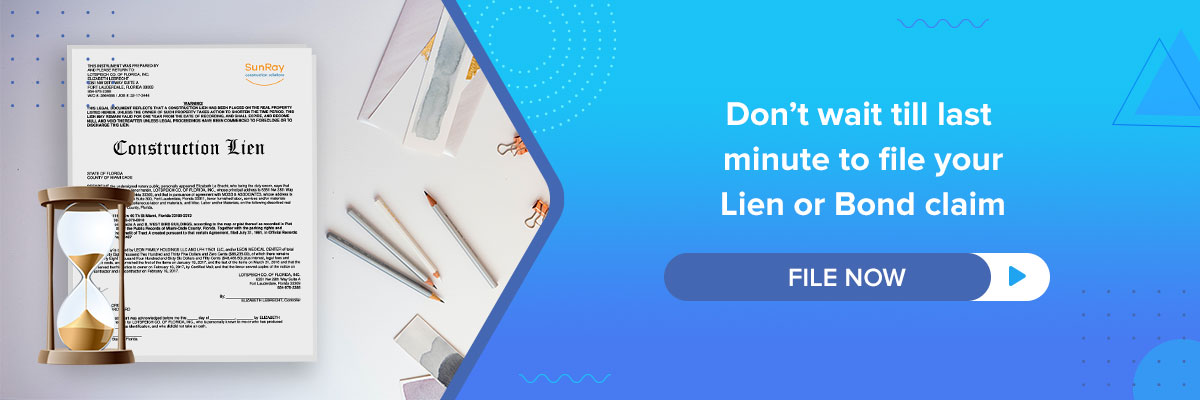How to Recover Your Legal Fees When You Collect A Debt - Webinar
There are two ways to recover your legal fees when you collect a debt. Learn what happens when you record a lien, why you should timely send your Notice to Owner, and what to do if you have a construction bond.
Last updated:
Nov
19
,
2025
Published:
Oct 15, 2020
11 Mins
Read
The focus of this webinar is on how recover your legal fees when you collect a debt, what happens when you sue on a written contract and when you record a lien, what to do if you have a construction bond, and you will also be able to have a look at a sample contract provision.
This blog was taken from a webinar presented by SunRay Construction Solutions and Alex Barthet. Alex is a board-certified construction lawyer serving clients in Florida. We will address how to recover your legal fees when you have to sue someone to collect a debt, as well as what to do if someone sues you for maybe claiming that you breached the contract.
Two Ways to Recover Legal Fees in Florida
In Florida there are effectively only two ways to recover your legal fees in a case:
1. Sue on a written contract that provides for the winner to recover their legal fees
If you sue someone for breaching any agreement or they sue you for breaching an agreement, that agreement needs to be in writing. It also needs to include a provision that says the winner gets their legal fees from the loser in the case.
2. Sue for violating a specific Florida Statute allowing for the prevailing party to recover legal fees
The second way is if you sue someone because they violated a specific law in the statute on the books in the state of Florida. And that law says that the winner can recover their legal fees from the non-prevailing party.
There are some other ways to recover your legal fees in the course of litigation that can allow one party to recover legal fees from another. But primarily speaking, these are the ways that legal fees are recoverable in the state of Florida.
1. Sue on a written contract that provides for the winner to recover their legal fees
Sample Contract Provision
Let us look a little deeper at what it means to recover fees because you have a written contract. There are several key components to this way of recovering legal fees.
- You need to have a written agreement
- This written agreement between you and the other party has to say that the winner gets their fees. There are many ways to write this and below is an example of one such provision:
“The prevailing party in any action to enforce this agreement shall be entitled to recover its costs, expenses and legal and paralegal fees from the non-prevailing party related to the collection, suit, or other legal action, including arbitration and appeal.”
Sometimes these provisions are shorter and sometimes they are longer. But they effectively say that the winner gets their fees from the loser. Now again, this has to be in writing. So, if you go to someone’s business and sell them something, or someone hires you to do some construction work or buys materials from you, and you have a handshake deal, you have no written agreement at all. Then if you want to sue the other party because they did not pay you, you will not recover your legal fees even if you win.
So, some nuances to this issue are what if you do not have a written agreement at the time you discuss the contract but when the other party sends the invoice it says that the winner has to pay their fees? It is much harder to prove that there was an agreement on fees if you just have it in your invoices.
A better scenario would be that you sent a purchase order and the purchase order had terms and conditions. Then you filled the purchase order and the other party paid for them, or some of the items on the purchase order. And now you can show that the terms and conditions on that purchase were part of the understanding between the parties. So even though it was not signed there, there is at least some indication that there was an agreement to the provisions.
By far, the best way to have a right to recover legal fees from a contract is (i) that it is in writing and (ii) that is signed and includes this provision. So, keep that in mind when you are reviewing your contracts.
2. Sue for violating a specific Florida Statute allowing for the prevailing party to recover legal fees
Florida Statute 713.29
This statute is the lien statute that deals with the recovery of legal fees. So, as you likely know, if you record a lien on a piece of property or make a claim on a bond because the contractor has issued a payment bond, you have certain rights. And one of those rights is that you are entitled to recover your legal fees if you prevail.

Florida Statute 713.29 says the following:
“In any action brought to enforce a lien or to enforce a claim against a bond under this part, the prevailing party is entitled to recover a reasonable fee for the services of her or his attorney for trial and appeal or for arbitration, in an amount to be determined by the court, which fee must be taxed as part of the prevailing party’s costs, as allowed in equitable action.”
So, if you record a lien on a piece of property and you win, one of the things that the judge may award to you is not only the amount that they determine is due under your agreement for the improvements you performed, but also the legal fees you incurred to prevail on the construction lien.
Sounds Simple. However..
This all sounds very simple but there are some things to keep in mind:
1. Most cases settle before trial (everyone eats their own fees, usually)
At any given time, there are multiple cases on and almost all of them settle prior to the actual trial date, prior to the judge issuing an order that someone wins, and someone loses. In those situations, a negotiated settlement usually includes some negotiation with respect to the recovery of legal fees. Everyone has spent legal fees up to that point and as part of the compromise, people are usually also negotiating the right to recover legal fees.
For example, if you are a supply house that recorded a lien on a piece of property, maybe you are the plumbing supply house for a plumber who did work for a contractor who has a contract with an owner. The plumbing supply house records a construction lien and now the owner of the property has to deal with it. In that case, usually you have a much better right to recover fees if you have timely sent our Notice to Owner.
Read more: Top 3 Requirements When Sending Notices to Owners

So, using SunRay, to send out the notice and the lien increases the likelihood that you are going to recover your legal fees. Because unless there was an issue with something like a delivery, like maybe you delivered the wrong materials, maybe there were counter pickups so you cannot show that they were incorporated. But assuming all those pieces work out, you have a pretty good right to recover fees. And in most cases, all of the fees are recovered due to the supply house because the owner has very little right to get out of it.
However, if there is a contested matter, maybe between a plumber and the contractor, at the end of the day, those cases usually get settled and fees are usually compromised. This is done to make the case go away and to reduce the risk of an adverse outcome at trial.
2. A party may prevail on some theories, but not others
A party may prevail on some theories, but not others. As a result of this, we come to the third point.
3. The court will decide which party is the prevailing party on the “significant issue” of the case
The party that prevails on the significant issues, if there is a right to recover legal fees, will be the prevailing party.
For example, if you have a lien claim and a breach of contract claim, and the court finds that no one prevails in the breach of contract claim, but you did prevail on the lien claim, then you would be able to recover your legal fees under the lien claim. But not necessarily the time that was spent on the contract claim.
More than a decade ago, the rule on the construction lien was if you want $1 on your lien, you would get your legal fees. That rule has changed over time and as a result, you have to prevail on the significant issues in the case. And the person that determines what those significant issues are and who prevailed on them is the judge. So, we are seeing more and more courts and judges not necessarily award the prevailing party all of his or her fees all the time. So, keep that in mind.
Protect Your Rights with a Notice to Owner
Sending a notice to owner is the first step to secure payment on construction projects. Learn how a notice to owner Florida helps protect your lien rights and ensures you get paid.
Best Practices
We will now talk about some best practices
1. Recognize that your ability to recover fees may drive the decisions in the case, or if to file at all
For example, a cabinet maker and installer who typically do much bigger work, but also do some work for homeowners, installed a $30,000 kitchen. The homeowner paid in installments on their credit card and once the work was done, for the last installment, they put a charge back on their card for $5,000. So, the credit card company took the money back from the cabinet installer and now the cabinet installer is owed $5,000. That is not an insignificant amount of money, but unfortunately if the cabinet installer does not have a construction lien on the property and does not have a written agreement that says the winner gets their legal fees, he will not get his money.
So as a result, if they hired someone or proceeded with a legal case, they may recover their $5,000 but they may spend that much or even as much as $10,000 to get there. As a result, they would be worse off not better off. So, the advice here unfortunately, aside from maybe sending a demand letter to get their attention, is that actually filing a lawsuit will be less productive. So, do not forget to include a fee provision in your contract. If you are talking to an attorney, make sure that you understand if you are proceeding with a case or defending a case, what exactly the ability to recover legal fees is.
2. When reviewing your contracts, include a provision so that the prevailing party may recover legal fees
Always include a provision that the prevailing party is entitled to recover legal fees. If the situation were to occur and you know that if you have to hire a lawyer you can recover your legal fees.













